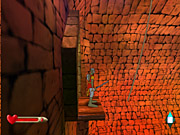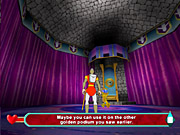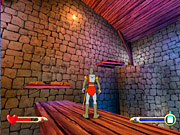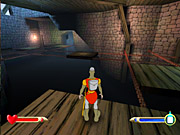Back in 1983, the original Dragon's Lair arcade game created by Rick Dyer, Don Bluth, Gary Goldman, John Pomeroy, and Chris Stone represented a remarkable technical achievement, as it used laser discs to essentially turn an animated cartoon into a playable video game. About 20 years later, the game has returned as Dragon's Lair 3D: Return to the Lair, a fully 3D game that uses cel-shaded graphics to attempt to re-create the cartoonlike appearance of the original game. And even though the excited testimonials of the original game's creators (which are included in the game as a three-part History of Dragon's Lair video retrospective) promise great things from the game, like its ability to take advantage of the extremely high resolution of high-definition TV, Dragon's Lair 3D simply isn't a very good game on its own merits. Its limited use of cel-shaded graphics, which seemed revolutionary when Dragon's Lair 3D was first revealed two years ago, is now thoroughly outdated, as is its simplistic, puzzle-based gameplay.

If you're familiar with the original Dragon's Lair, you'll remember that it was a simplistic action game that generally relied on your reflexes to solve simple puzzles as Dirk the Daring, a bumbling knight on a quest to rescue the fair princess Daphne from the evil wizard Mordroc and the dragon Singe. That game featured colorful, fluid, hand-drawn cartoon animation, while Dragon's Lair 3D features minimal use of cel-shaded graphics. Dragon's Lair 3D looked absolutely remarkable when it was first revealed by German publisher Blue Byte at the E3 convention in 2000, but that was more than two years ago.
In fact, it was trumped later that same year by Sega's artful Dreamcast game Jet Grind Radio (a game about a roller-blading gang that sprays their city with graffiti), which featured imaginative cartoon characters and colorful special effects that looked like nothing less than graffiti art come to life. Since then, lots of console games have gone on to use cel-shaded graphics to great effect, and Dragon's Lair 3D's limited use of the graphics technique, which is used only for Dirk and a few of his foes, is thoroughly unimpressive by today's standards. Even though Dirk himself looks decent enough, the dungeons he explores aren't cel-shaded and are textured extremely simply, apparently to match the cartoonlike look of Dirk, and they're so dull and drab that visually, Dirk sticks out like a sore thumb. It should also be noted that unless you happen to have your computer hooked up to a high-definition TV set, you won't be able to benefit from Dragon's Lair 3D's highest resolutions; on a standard computer monitor, you'll be able to see only part of the action--the upper-left part to be precise, since everything else gets chopped off.

Dragon's Lair 3D sounds about as good as it looks. The game features a grandiose symphonic soundtrack, which is, according to the "History of" videos, provided by a 70-piece orchestra, though the music is mainly ambient and easy to tune out, other than the same flourish you'll hear played over and over when Dirk finishes each of his challenges. The game also has sparse but decent voice acting; Dirk himself has no speaking lines, just like in the original Dragon's Lair, but instead makes a few cowardly noises when he's wounded or falls. Unfortunately, he has very few of these voice samples, and the one you'll hear the most, and probably get sick of the fastest, is the chimpanzee-like shriek he lets out whenever he takes damage. However, the game also features a good deal of voice-over from the breathless and ditzy Princess Daphne, who provides Dirk with hints through a magic amulet, and this voice-over is considerably better than Dirk's.
A more important concern is whether you'd want to play Dragon's Lair 3D in the first place. It's true that the developers and producers at DragonStone Software and Ubi Soft have done a good job of re-creating the pace of the original Dragon's Lair, which consisted of a series of brief, separate puzzles that you had to complete individually before moving on to the next. And Dragon's Lair 3D's challenges are arranged similarly, but they're either too simplistic--such as a challenge that simply requires you to fight a few enemies--or too frustrating, like the game's many jump-across-a-pit puzzles, thanks to the game's inadequate control scheme and occasionally unreliable camera.

By default, Dirk walks extremely slowly, and in order to make him run fast enough to complete some of the game's more-challenging jumping puzzles, you need to press and hold an additional "run" button or key while timing your jumps. If you misjudge a jump distance, which happens a bit too often, Dirk falls to his death. Unfortunately for Dirk, he isn't exactly spry, and he'll sometimes react slightly late if you order him to jump, and to make matters worse, he has only two camera options to work with: a camera that's either inadequately fixed in one place ora camera that moves with mouselook but still isn't helpful when dealing with long jumps or climbing up to platforms above his head. And unfortunately, most of the game's levels consist of these frustrating jumping puzzles, so you'll spend precious little time fighting dragons and rescuing princesses and most of your time falling to your death.
Otherwise, Dirk must deal with simplistic puzzles, like moving an object from one location to another or drawing his sword and fighting his enemies, which can be accomplished by alternately attacking and carefully parrying each incoming blow but is most effective when you simply hack randomly at your enemies until they're all defeated. The PC version of the game has an "auto-target" button that doesn't seem to work and isn't even necessary, since many enemies get stunned briefly when hit, which lets you finish them off easily.
To be sure, there are plenty of these relatively brief challenges--more than 200 in all--but it's clear that they were modeled after the comparably brief challenges of the original Dragon's Lair, and despite some of the frustrating jumps, they're almost as simplistic. Unfortunately, many innovative and highly enjoyable video games have been developed and released between 1983 and now--games that have featured many more exciting things to do than hacking blindly at two knights until some door opens. Back in the days of the original Dragon's Lair, risking your life to leap across a bottomless chasm might have seemed like an exciting adventure--these days, it's a tired action-game cliché that's more of an annoyance than anything else.

When you watch the included "History of" videos that come with Dragon's Lair 3D, you'll get a good idea of the storied past behind the original arcade game. You'll also get to watch interviews with the original game's creators at E3 2002, including an interview with veteran animator Don Bluth, who confides that the main reason he agreed to help produce Dragon's Lair 3D was the exciting prospect of giving players full control over Dirk the Daring in real time (rather than the limited control that the original arcade game afforded players). Mr. Bluth and his colleagues have produced a number of acclaimed animated motion pictures, such as An American Tail and All Dogs Go to Heaven, but unfortunately, they don't seem to have paid much attention to the fact that hundreds of video games have given full control of colorful, interesting characters to players for many, many years now. If Dragon's Lair 3D had been released in 2000 by Blue Byte, as was originally planned, it might have been hailed as a technically innovative game, much like the original game was in 1983. But two years later, just about every aspect of Dragon's Lair 3D seems outdated. It might make a good collector's item, but it's not much of a game.



